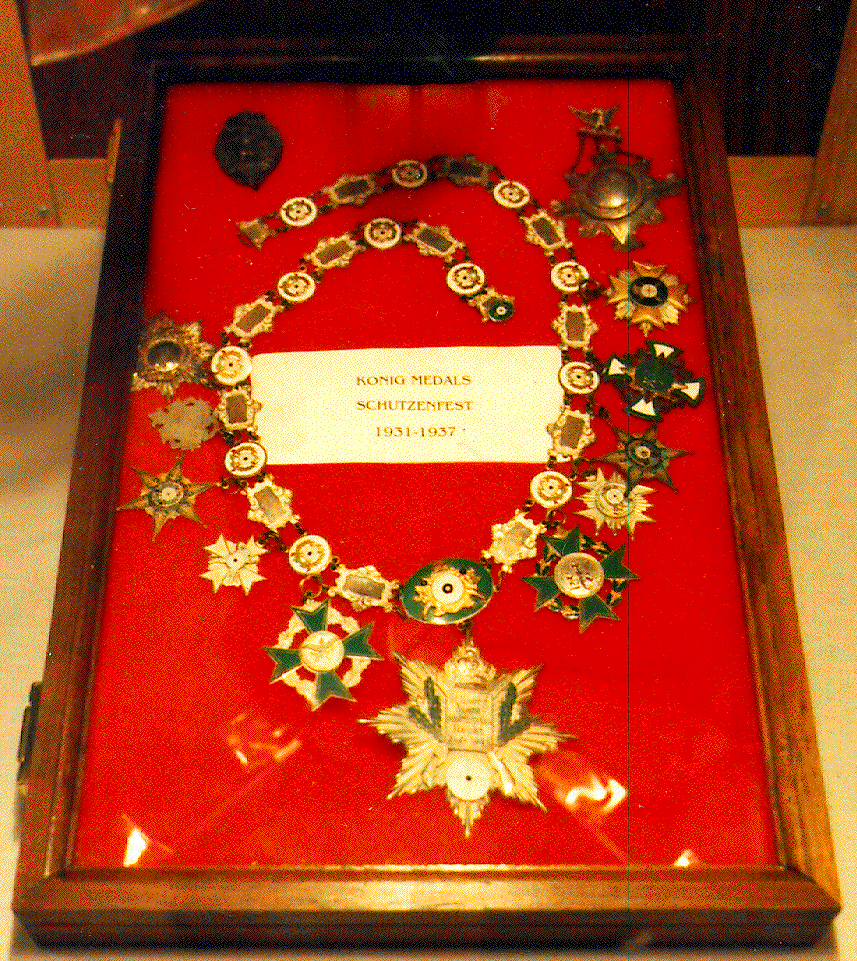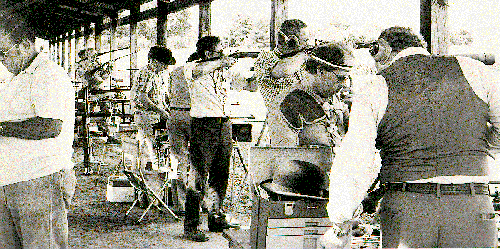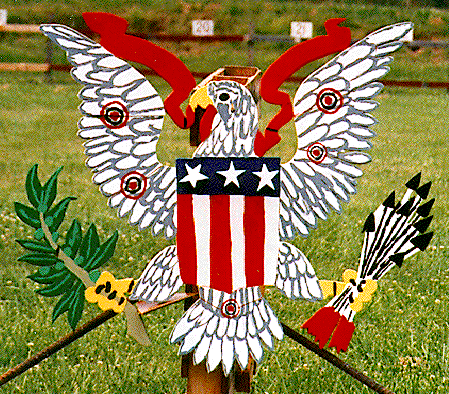|
Muzzle Blasts Online |
|
...for the muzzleloading enthusiast |
|
The muzzleblasts.com domain, subdomains, content, etc., are neither affiliated with the NMLRA nor its paper magazine Muzzle Blasts |
|
Muzzle Blasts Online |

|
|
|
|
|
|
by Tom Schiffer
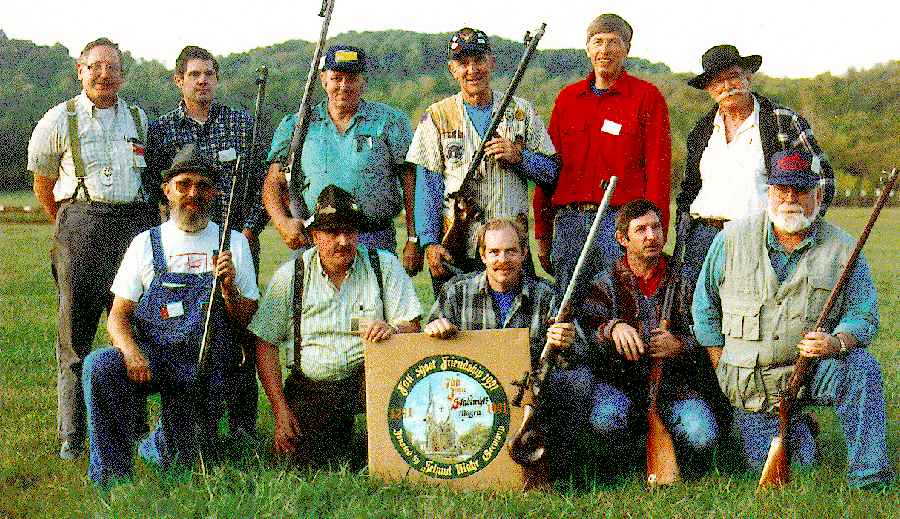
|
|
Schuetzen Competitors |
In Europe the format for determining shooting ability differs in two basic ways. In one, an effigy eagle (adler) or bird (vogel) is constructed of wood. In the contest, it is shot to pieces by the shooters, who queue up and shoot one at a time. The shooter downing various designated pieces, such as the wing, foot, or head, is awarded prize money. The shooter downing the last piece is declared king (k”nig).

|
|
Brad Richardson, NMLRA Schuetzen Koeing 1989, shows the painted target furnished by 1988 koing Art Allen. |
The underlying desire of these matches was to honor and encourage marksmanship in the local townsmen as a means of defending the community against aggression. In the often war-like Europe, recurring painting themes were wishes for peace and prosperity, as well as invocations that God change things for the good.
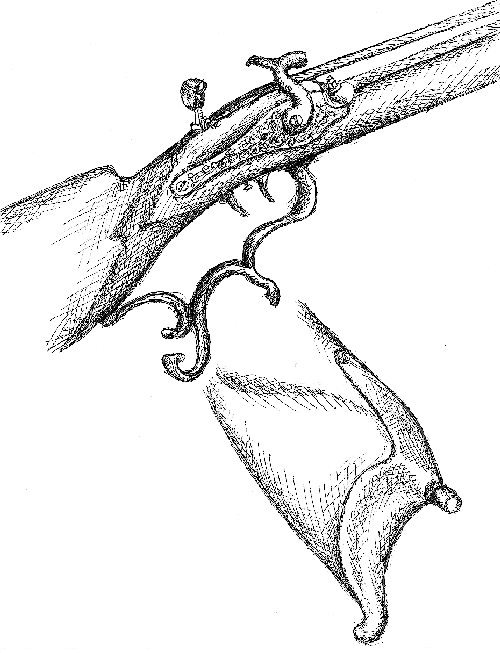
|
|
Common features of schuetzen rifles are hooked buttplates, intricate trigger guards, adjustable sights, and set triggers. Illustrations by Andrew Schiffer. |
A schuetzen rifle cannot be rigidly defined. However, features commonly found are heavy barrels, adjustable sights, set triggers, deeply curved or hooked buttplates, ornate stocks with sufficient drop for offhand shooting, and intricate trigger guards to support the trigger hand. Caliber and barrel twist reflect the needs of the competition. Large-bore roundball rifles were no doubt desired by those shooting the eagle or bird; smaller bore, elongated-bullet rifles were better suited to the longer distances of 200-meter shooting. An article by this author in the April 1982 issue of Muzzle Blasts, ``Schuetzen Rifle Shooting,'' gives some details about contemporary muzzleloading schuetzen shooting. Ned H. Roberts' The Muzzle-Loading Cap Lock Rifle and Walter Cline's The Muzzle-Loading Rifle: Then and Now are classic works that tell something of the sport in earlier times within this country.

|
|
A typical American longrifle (top) is shown in comparison with a typical schuetzen rifle. Illustrations by Andrew Schiffer. |
Most, but not all, of these clubs and their traditions were driven out of existence in the anti-German hysteria of World War One. An account of a schuetzen group disbanded by anti-German activity, ``The Deutsch Schuetzen Gesellschaft of Covington, Kentucky,'' was in the March 1984 issue of Muzzle Blasts. Schuetzen matches are still held in several parts of the U.S. However, besides the NMLRA matches mentioned below, the author knows of no other muzzleloading schuetzen matches.
The NMLRA Schuetzen Program has existed since 1975, and it has expanded over the years. It now features several different formats. The NMLRA National Shoots feature aggregates of offhand matches at 100 and 200 yards. These are matches shot at paper targets. In addition, there have been matches at painted targets and birds (adler or vogel).
The first vogel or eagle match was held in June 1994 (see the January 1995 Muzzle Blasts for details), and was repeated in 1995. In this match, the effigy bird or eagle is shot to pieces. The match was met with much enthusiasm and it may well become a permanent part of our shooting program. In reviewing the January 1995 write-up on the vogel match, the writer feels that it is time to offer the reader who does not participate in the NMLRA Schuetzen Program some perspective on it.
For many years there was only the Red Farris Match to attract those of us interested in schuetzen-style shooting. It was a roundball, any metallic sight match that allowed use of the hip-rest offhand position as well as the arm-extended one. These were the only concessions to a schuetzen shooter. In 1968 a request was made to the NMLRA Match Committee for a schuetzen match in which elongated bullets might be used.
In response to the request, a new NMLRA match was created in 1975. It called for five shots at 200 yards on the 200-yard target, which has a 10 ring and which has a lowest ring count to 6. This was the real start of the schuetzen program at the NMLRA.
The match has been won using roundball. Indeed, the early record was set with a flintlock Kentucky longrifle of .45 caliber that was aimed over the top of the target frame and some three feet into the wind. This record score of 43X stood for some years. It remains possible for a competitor to use a roundball in this match; however, the wind must be consistent or calm to be competitive. These are conditions not often found on the Walter Cline National Range in Friendship, Indiana.
Picket bullets made their appearance early on in schuetzen competition, and later bullets grooved for lubricants and paper-patched elongated bullets were used. Some very interesting rifles made their way on the range. Some were original and others newly made. Many muzzleloading rifle-makers of the time were frustrated by would-be customers who wanted to order a schuetzen rifle. The number of rifle makers who understand what is required for a schuetzen rifle remains relatively small.
Reentry matches were added to the program to give those who shot only the Schuetzen Program something to do all week. They also provide a vehicle for practice. Only the reentry matches may be fired using rifles fitted with any sight (telescope included); the aggregate must be fired with metallic sights. This is a concession to those of us who can no longer see the target over metallic sights, but who want to remain active as offhand schuetzen shooters.

|
|
In 1994, 11 years after Carol and Andy Schiffer honored the association's 50th anniversary, Jim Tucker prepared this target for the 1994 König Match. |

|
|
This unusual könig target was made by Mike Yazel, 1990 schuetzen king of the NMLRA. The wooden target is not painted, but is carved in bas relief. It was won by Gary Frecking in 1991. |

|
|
Helmut Mohr of Mayen-Hausen, Germany, donated this painted target during the 1991 NMLRA National Fall Shoot. |
In 1994 Rod England and his son Adam furnished to the association an effigy eagle that was to be shot down a piece at a time. This event was repeated in 1995 utilizing a bird made by the 1994 winner, Russ Combs. The winner in 1995 was Dana Forslund, with Roy Gatlin and Jack Stoner runners up.
The NMLRA Schuetzen Program matured over the years, and better equipment appeared on the firing line. Roundball gave way to picket bullet, which in turn gave way to the elongated bullet. It may look like the participants could not read their history books and had to reinvent the wheel. In actuality we used what we could get (find and afford), and it happened to parallel the original evolution of materials. Rifles, equipment, and loading techniques were shared because, even if the shooter could afford these things, they were not readily available.
As time and circumstances permitted, most all competitors acquired their own rifles and equipment; there was no longer any need to share them. From time to time, muskets and long-range bulleted rifles like the Whitworth were tried with varying degrees of success. While accuracy was seldom a problem, these efforts usually foundered on the shoals of excessive recoil.
Equipment has settled on a rifle of .38 caliber weighing 10 to 12 pounds, with a rifling twist rate of one turn in 16 to 18 inches and firing a bullet of 250 to 300 grains. Powder charges seldom exceed 55 grains. Sights are the traditional peep rear and open or globe front sight. While click adjustable sights are allowed, they are not felt by this writer to be in the tradition of the original matches. The are a definite advantage over the original equipment.
During the 1994 National Championship Shoot, the NMLRA Museum at Friendship, Indiana, featured a one-time showing of original schuetzen muzzleloading rifles. This collection of equipment likely represented the largest number of fine original muzzleloading schuetzen rifles in one place on these shores during our lifetimes. This exhibit was organized by Donna and Roy Gatlin along with Rod England. It was obviously done with the help of many owners, most of whom did not wish to be known. To those who appreciate the rarity and quality of such rifles, this was a stunning event!
In recent years, a roundball schuetzen program has been contemplated to augment the current matches, which are designed primarily for elongated bullets. There is much tradition to suggest we do this. Most of the antique schuetzen rifles were made for roundballs, the main difference being rifling twist rate. There are those of us who have such rifles and would use them if the match or matches were made available. A roundball schuetzen rifle of large caliber would be ideal for the eagle match, which is a relatively short-range match that would concede advantages to a large-diameter roundball.
The schuetzen program has a relatively small but dedicated following at the NMLRA Nationals. Pretty much the same people keep coming back year after year. To take nothing away from the traditional roundball competitions, more sophisticated equipment and technique is required. Wind deflection at 200 yards is not twice that of 100 yards, it is four times as great.
If our infrequent(?), boisterous enthusiasm has escaped being called down by a long-suffering range officer, it might be because he or she was invited to take a shot from time to time. It might just also be that the official knows a good thing when he or she sees (and hears) it.
If you manage to hang around this bunch of schuetzen enthusiasts and look interested enough, you may be invited to take a shot or two or even shoot a match. Time permitting, and sometimes even without time permitting, participants will share their ``secrets'' with you. But keep in mind that we bear no responsibility to irate spouses if you get hooked. After all, most of us have already been down that path and have (thus far) survived. And furthermore, there are some secrets you just don't share!
1996 Eagle Match
On Saturday, June 8, 1996, at the NMLRA National Championship Shoot in Friendship, Indiana, there will be an NMLRA Eagle Match during the last two relays. Come and enjoy the fine traditions of schuetzen competition with us.

